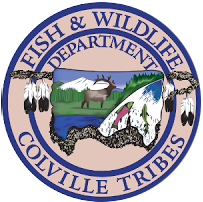History of the Confederated Tribes of the Colville Reservation
Executive Order
The original Colville Indian Reservation was established by Executive Order April 9, 1872, for the use and occupancy of the Methow, Okanogan, San Poil, Lake, Colville, Calispel, Spokane, Coeur d'Alene and such other Indians as the Department saw fit to locate thereon. Other tribes located on the reservation were the Snake River Palouse branch of the Yakima, the Joseph band of the Nez Perce, the Moses Columbia, and the Wenatchee band of Indians.
North and South Halves
The original Colville Reservation was in existence for less than three months when it was exchanged for the present reservation under Executive Order of July 2, 1872. The present reservation of approximately 2,900,000 acres was divided into the North and South halves by the Act of July 1, 1892, which restored the North Half, consisting of approximately 1,500,000 acres, to the public domain. There was a group of tribes under the leadership of Chief Moses which resided during the early 1880’s on the Columbia Reservation in the State of Washington. This group of tribes included (1) the Columbia, (2) Chelan, (3) Entiat and (4) Wenatchee. The Columbia Reservation was established by Executive Order of April 19, 1879, as amended by Executive Orders of March 6, 1880, and February 23, 1883, “for the permanent use and occupancy of Chief Moses and his people, and such other friendly Indians as may elect to settle thereon with his consent and that of the Secretary of the Interior.”
Chief Moses Group
On July 7, 1883, an Agreement was made in Washington, D. C., signed by the Secretary of the Interior and the Commissioner of Indian Affairs, which contained a provision that, if the Chief Moses group of tribes and other Indians who were then residing on the Columbia Reservation would move to the Colville Reservation, the United States “will secure to Chief Moses and his people as well as to all other Indians who may go on the Colville Reservation equal rights and protection.” This Agreement was ratified by the Act of Congress of July 4, 1884 (23 Stat. 76, 79-80). Subsequently, starting in or about 1886, members of the Chief Moses tribal groups were moved to the Colville Reservation. Also, during the year 1885 and later years, the Government moved to the Colville reservation, members of the Joseph Band of Nez Perce Indians and members of the Palus Tribe.
Land Status as of 1970
The land status of the Colville Reservation on June 30, 1970, is as follows:
Tribal Trust ................ 935,440
Individual Trust .......... 67,998
Non Trust. ................ 410,695
Total ...................... 1,414,133 acres
Time Line
1855 Walla Walla Treaty with the Nez Perce creating the Nez Perce Reservation.
1863 Reduction of the Nez Perce Reservation.
1872 First Colville Reservation established on the Spokane side of the Columbia River. Current Reservation established July 2, 1872 by Presidential Executive Order for the Methow, Okanogan, Sanpoil, Lakes and Colville. It also included the Spokane, Kalispel and Coeur d’Alene because they were assigned to the first reservation – but they never moved to this reservation. At that time, the Nespelem were included as a band of the Sanpoil.
1873 Chief Joseph Band Reservation established.
1875 Chief Joseph Reservation dissolved.
1879 Moses or Columbia Reservation set aside for Chief Moses and his people. After the wars with the United States, many of the mid-Columbia tribes banded together under Moses’ leadership. At that time, his people included Wenatchi, Chelan and Entiat.
1879 Carlisle Indian School, Carlisle, Pennsylvania.
1883 Moses Columbia Reserve returned to public domain.
1884 Chief Moses makes an agreement with the United States to move to the Colville Reservation.
1885 Chief Moses invited Chief Joseph and his band to stay on the Colville Reservation and they are allowed to do so.
1886 Chief Moses’ people moved from the old Moses Reserve to the Colville Reservation by Executive Order.
1892 North Half of Colville Reservation Ceded.
1892 St. Mary’s Mission starts Indian boarding school, now Pascal Sherman Indian School.
1900+ The Palus remained in their homeland as long as they could; people lived at Palus Village until 1950. Many Palus families slowly moved to the Colville Reservation.
1900-14 Fort Spokane Indian Boarding School.
1906 Indian allotments on the South Half.
1916 Un-allotted “surplus” lands on the South Half open to settlement.
1929-33 Rock Island Dam.
1934-37 Bonneville Dam.
1933-42 Grand Coulee Dam.
1941-54 McNary Dam.
1946-55 Chief Joseph Dam.
1950-61 Priest Rapids Dam.
1952-60 Dalles Dam.
1956 818,227 acres of undisposed surplus lands return to Colville Tribes
1956-61 Rocky Reach Dam.
1955-62 Ice Harbor Dam.
1959-63 Wanapum Dam.
1964-68 Keenleyside Dam.
1964-73 Mica Dam.
1964-84 Revelstoke Dam.
1967 Wells Dam.
1961-69 Lower Monumental Dam.
1965-75 Lower Granite Dam.
1963-70 Little Goose Dam.
